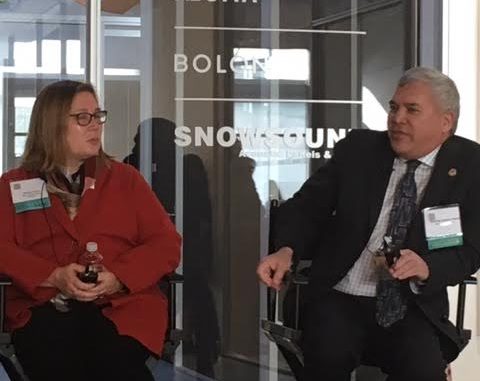
On Friday, Feb 15, 2019 the Helms Bakery District was the scene of a unique panel hosted by the Westside Urban Forum discussing a compelling topic; the mayors of Santa Monica, Beverly Hills, Culver City and West Hollywood spoke to “Governance in Times of Prosperity.” Moderated by Amy Freilich of Armbruster, Goldsmith and Delvac, a firm specializing in real estate law, the questions were incisive and the answers were insightful.
Culver City Mayor Thomas Small was joined by Santa Monica Mayor Gleam Davis, Beverly Hills Mayor Dr. Julian Gold and West Hollywood Mayor Pro Tem John D’Amico. All of these small cities on the westside grapple with issues of housing, traffic, parking, development and jobs. What the future will look like depends on how they address these issues now.
Freilich started the discussion with the observation that these are the good times, economically. Commerce is booming, but that makes the turf even more highly desirable, and housing is one premium priority that many agreed was the ticket to making the rest of these challenges easier.
Mayor Small noted that Culver City was keenly focused on the housing issue. “We currently have 26 programs relating to housing, many of them thanks to Sol Blumenfeld [Culver City’s Community Development Director]. We’ve had to struggle with our height restrictions – we limit to 56 feet, hard stop – but I am convinced that density is the way creating more walkable, more livable urban space.”
Santa Monica’s policy of 30% affordable housing is mandated for new developments, but Mayor Davis also noted that “since the law had been passed – it was a local ballot initiative – we have not had a development offer to meet the standard. When we had a 20 % requirement, we found that we could do that, but 30% does not seem to be happening.”
Mayor Gold reflected on the fact that Beverly Hills was, for better or worse, Beverly Hills. “We are a city that is known for luxury housing, and while there are residents who do not want anything to change, change is coming our way because of demographics.” The population of school age children has declined and continues to shrink, putting Beverly Hills in a position of needing to be more available to young families. That might mean a shift in development towards more – and less expensive – housing units.
Encouraging work force housing was seen as critical to all the municipalities.
West Hollywood, the smallest city in the group, considered the impact of traffic. Mayor Pro Tem D’Amico stated that “We only have 6% of the population that makes enough money working in West Hollywood to live in West Hollywood. That number used to be higher, but it’s gone down in recent years. That means we have a lot of people who get in their cars and drive to work [elsewhere] and a lot of cars coming in for people to work in West Hollywood. ”
Climate change was acknowledged to be the compelling force for coming up with new and better solutions.
Davis made the point that Santa Monica’s famous beaches could be a memory in a hundred years. “We can’t cling to this identity as a laid back, easy going beach city. We need to be a fully functional, forward looking city and know that we might not even have beaches.”
The need for extreme efficiency to support density was also brought up. D’Amico noted WeHo’s height limit of four stories, and said, “It’s not just about turning four stories into eight stories; it’s making those eight stories function like two stories in terms of water, electricity and other amenities like trash.” He likened his city’s approach to being “a laboratory on a pirate ship; we find an idea that might work, we steal a concept that looks promising, and then try it out and see how it works for us.”
Gold candidly confessed, “We don’t know what the future is going to look like, but it’s not going to look like today.”
The General Plan Update for Culver City was what Small spoke about as possible blueprint for the future. “We are focused on growth and inclusivity, studying each of these issues of sustainability, transportation and housing to create solutions to these very inspiring challenges that we are all facing.”
Judith Martin-Straw
Photo: Santa Monica Mayor Gleam Davis with Culver City Mayor Thomas Small


Be the first to comment